Einleitung | introduction
Consistent with our philosophy to overinvest in the absurd (and at a time when the market is, well, “unenthused” let’s say, because of inflation and wars, and I suppose partly because of politics and the decline of western culture and our lack of collective resolve, empathy and humanity, etc. and so forth), we decided to really go deep this year.

Powered by German junk food, John and Collin estimate they tasted around 500 wines, sleeping an average of 4-5 hours a night. I tasted much less and slept a refreshing 8 hours a night.
So I went to Germany for my normal two-week trip in early March to see our growers and friends. Early March is, by the way, the absolute worst time to taste the new vintage. Most wines are done fermenting, normally, yet not racked, or recently racked, or recently filtered (yikes!) or even recently sulfured (it’s true, sorry). They are a mess, pre-pubescent and confused, awkward.
Yet, honestly, the older I get the less patience I have to really play the charade of trying to “understand” the vintage, pretending to wrap it up into some neat little narrative for the market to absorb (such as I am doing here). There is reason to believe, as I outline in the next section called “the lies,” that vintages truly are getting more complex to narrate.
At the same time the older I get the more meaningful these trips are. The more I enjoy them. I smile more on these trips than I did ten years ago. I’m more grateful for an existence that lets me write off sitting with amazing humans and talking about their year. And not to be morbid, but each trip represents another year I’ll never have again. Wine, in a way, is just a way of trying to understand time, and ourselves floating around in that time.
That said, for all the smiling and floating, well, I also did work work. I got around: Rheingau, Mosel, Pfalz, Württemberg, Baden, Rheinhessen, Saar and back. Not bad for two weeks.
Then, because John and Collin have both worked their asses off and deserve to have ownership and authorship of our annual vintage assessment – and because I want them to have this joy – they both spent two weeks in Germany in late April. Being younger, smarter, and more foolish than I, their calendar was more insane. John said he calculated they tasted 500 wines, sleeping four to five hours a night. (Me, I tasted much less and slept a lovely eight hours a night.)
I write all of this, I suppose, to firmly sew our hearts onto our sleeves, in case you hadn’t noticed already: Germany, and the culture of German wine, is our overriding purpose and passion. Unwisely, as any financial advisor would tell you, we have not diversified.
Instead, we have put nearly all our chips on German wine, on supporting these growers and this culture.
We hope this vintage report is of some use; we hope the deeper context of German viticulture, the work we do every day and every year focusing on Germany, offers you value. We hope, verily, that when you think of German wine, you think of us… and you support us. The truth is we have no Sancerre to sell, no BTG-able Chianti. We have nothing else to fall back onto. This extreme focus is a huge advantage, I think…. but it is also a huge liability.
Thank you. As always, with any questions whatsoever, we (a real human and not an autoresponder) are here: orders@vomboden.com
die Lügen | the lies
I am less convinced, every year, that “vintage reports,” as we generally understand them, are relevant at all anymore. To some extent, this has always been the case. These reports are lies, they are stories told to make something complex, easily digestible.
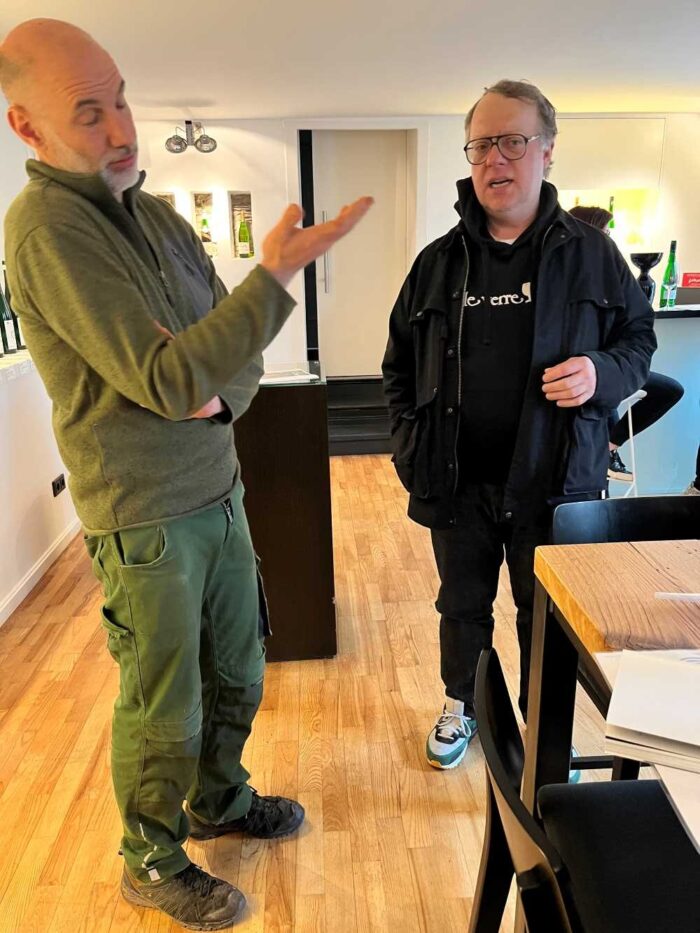
Justin Chearno, one of the Four Horsemen of Brooklyn’s restaurant, The Four Horsemen, asks Lauer about his sulfur usage. Lauer all of a sudden can’t quite remember…
But now, in this new world, these simple stories are even more deceptive.
To an unprecedented degree the “quality” of the wines of a single vintage is being pulled further and further apart. The wines tasted at one estate may have nothing whatsoever to do with the wines tasted at a neighbor one village over. Honestly, the experience is unnerving.
I believe two key factors are at play.
First: If the grower of the 20th century had one basic task (maximize ripeness), the grower of the 21st century may be asked to maximize ripeness, or to slow down ripeness a little, or maybe even a lot, depending on the year. Growers are now faced with unprecedented growing seasons that can be hotter and drier than ever before, or not. More and more growers now need to intuit the vintage in real-time, making choices in June that may prove to be wise or foolish only in September. In our more specialized and informed markets, many of the most successful growers are focusing their work on limited styles (Julian Haart, for example, certainly focuses on Kabinetts and dry Rieslings at the expense of Spätlesen or Auslesen) while others remain more generalists. I have the sense that “the touch” of the grower, her or his ability to read the vintage and respond quickly, is becoming more and more important. Those who are really in their vineyards, those who are really doing the work, they are making better and better wines every year… in some cases despite the vintage.
The inverse can be said for growers who are less in touch with their vineyards.
Second: Once relatively stable, the fall weather is more variable now than it has ever been. The culture of “the harvest” that developed over decades and even centuries, this village-wide event that could last three, four, five weeks or longer, may now, depending on the vintage, be compressed into a matter of days. Additionally, many wineries have shuttered. Because of this, the ultra-local and highly skilled workforce is no longer there. As in the U.S., much of the real agricultural labor of the harvest is done by workers from other countries. This can be very skilled labor to be sure, yet it is not easy to organize on a large scale, nor quickly.
These are profound developments that are literally rewriting all the rules. We would be wise to realize the old systems simply don’t work anymore in this new world. It’s as simple as that.
In this new world, I believe much of this comes down to a question of scale and of labor. The smaller estates that have fewer hectares to cover and can more easily read, not the tea leaves, but the vine leaves during the season have the advantage. These estates can also increase their harvest teams at a moment’s notice (going from five to ten is possible; going from 50 to 100 is impossible) and process the fruit with more speed.
Small estates are the obvious winners in this new world – and you can taste it in a vintage like 2023.
die Weine | the Wines
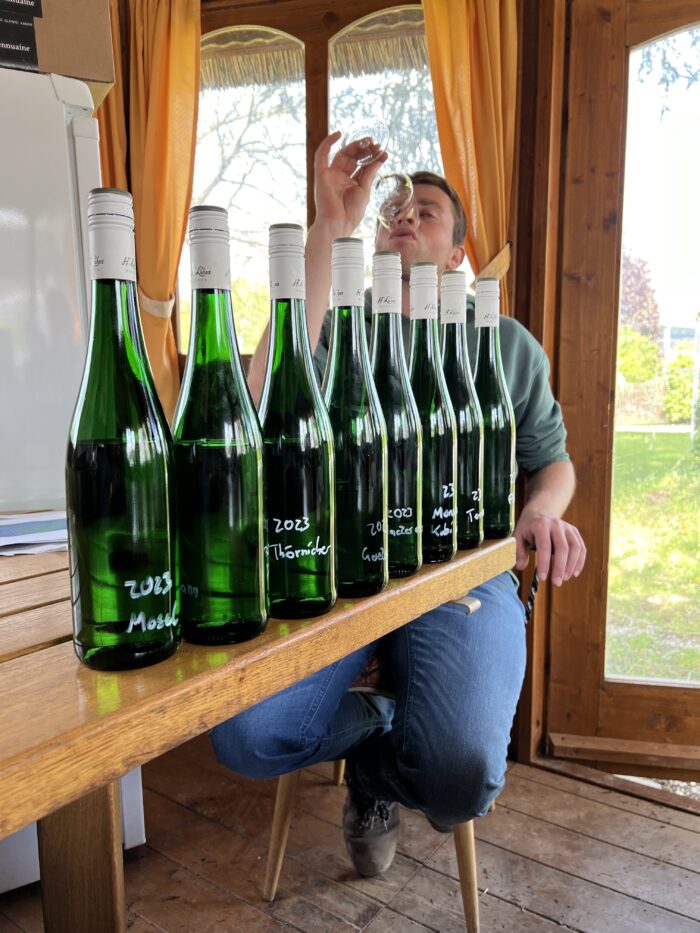
Julian Ludes with his 2023ers in the hippest tasting cabana in the Mosel.
The only easy truth of 2023 is the following: This is a very heterogeneous vintage.
There is no easy narrative, no one phrase to succinctly define the vintage. This is probably why you haven’t heard much about the vintage. It is wildly complex, divergent and just not-at-all easy.
But we also hope that perhaps this is exactly why you’re here? (Both on our website reading this vintage report, but also into German wines?) Maybe this profound variation, the extreme sensitivity to time and place, is what brought you to German wine?
If this is not the greatest vintage of all time, it’s also not a terrible vintage. It’s not even a mediocre vintage. It contains multitudes – everything.
There are *profound* wines to be had. These wines come from the growers who did a tremendous amount of hard work. This work was driven by intuition, by attention to detail, by feel. Their work was done at the right times, and they were able to harvest and sort clean fruit and allowed this juice-becoming-wine to ferment to the right dryness level with the acidity to match.
The growers who were successful, as is most often the case, are generally smaller in scale, love and know their vineyards in detail. It was that easy. Which of course is not easy at all.
Now the wines. Well, it was a warm vintage, with lots of water, finishing with a complicated harvest. The specific details differ for each region of course, but there was no place where this vintage was easy.
Analytically the numbers aren’t that far off from 2022 (moderate ripeness levels, moderate acidities), yet the presentation feels very different. The weather was basically the polar opposite: While 2022 was warmer (2023 did not have any heat spikes), 2022 was absolutely dry while 2023 saw good rains from late July on. This obviously affects the wines. The dryness of 2022 not only stopped much of the sugar accumulation in the grapes, but it also pulled back the curtains on the wines in a way: There was no dry extract to cover up what the wines are. Despite the warmth of the vintage, they had a lightness to them.
On the other hand, the generous water in 2023 provided plentiful extract and more. So even in cases where the acid is as high (or sometimes higher) than in 2022, the feeling is different. The wines feel more curvaceous.
At its most basic, 2023 is a ripe vintage and you can often taste it – sometimes in a good way… sometimes in a less-good way. Many of the wines are uncannily approachable (even at this young stage), exceedingly charming with fresh floral aromatics, pillow-like textures that billow across the palate with classic aromatics. The Rieslings can be exuberant and even heady, with ripe peach and stone fruit notes. In the top wines of 2023, this exuberant energy is contained and shaped into something harmonic and balanced. These wines have a really mouthwatering equilibrium. They are seamless and sorta perfect, serpentine with energy that ripples through them giving them superb delineation and length. Many of these wines are exceedingly pure and fresh, they contain this fullness in a way that makes them feel aromatic and expansive.

Julian Haart, fashion guy.
The flipside of this vintage is that many wines do not contain this fullness; they feel oily and heavy.
And then we have the top-top wines of the vintage; wines that seem to transcend the vintage. Somehow, with these wines, the winemakers were able to shape the “generosity” of 2023 into something more akin to “intensity.” The fruit and power is there, yet it is just concentrated, compact, almost linear and cutting. Some can even feel raw, the citrus and florality searing and incisive. Hot damn these wines make my head explode.
I suspect that all the people not reading this vintage report, a population more well-adjusted and integrated into normal human society than we, will love most of the wines of this vintage – at least from our small book. They are easy to enjoy.
Yet for the “vom Boden buyer” – you, the dork reading this vintage report! – who relishes the tautness and vigor of wine, do not write off this vintage. That would be a lazy mistake. There are wines of this vintage you should not miss.
We (I’m going to use “we” because John and Collin’s extensive tastings and great insight are included here) had the sense that the basic wines are wonderful and wonderfully approachable – but maybe not profound. They tend to show a bit more fruit. Weiser-Künstler’s basic “Feinherb,” which regularly perplexes normal drinkers as a green-apple-tinged salt-lick, is in 2023 the friendliest version I’ve ever had. It drinks like a Feinherb. It’s wonderful to be honest (and selling beautifully just FYI) but it’s maybe not typical for them?
We certainly had the general sense that the mid- to higher-level wines are sorta where the serious action is in 2023 – at least for the vom Boden buyer. With the rains and fast-changing conditions (we’ll cover the weather below), growers had to pick and choose what to focus on. When possible, they focused on their important, single-vineyard wines (whether dry or not dry) and took in the grapes for the more basic wines when they had time. All this is to say the mid- to higher-level wines tend to show much more tension and finesse. The basic wines tend to show a bit more fruit.
Mosel Fine Wines – two tasters I greatly admire – put the strength of the 2023 vintage at the Kabinett level in their great vintage report you should (and can) read here. As far as the Prädikat wines go, we honestly felt that the Spätlesen of 2023 were more the center of this vintage, in quality and “essence” if not in quantity.
It’s a damn shame that Spätlese becomes more difficult to sell every year. This fact is above our pay grade or sphere of influence, unfortunately. We have a ridiculous saying we try and banter about to promote Spätlese – “Spätlese is the new Kabinett” – and it’s sorta true. Since maybe 2010 growers have been very conscious of all the “sugar creep” – the fact that all the wines were getting sweeter and sweeter every year. That, and the fact that all winemakers and wine drinkers talk more and more every year about lightness and acidity, means that Spätlesen truly are becoming more and more drinkable every year. This vintage, 2023, feels like something of a real turning point. The best of them have nothing to do with the dessert wines you may have been served ten years ago.
“100-point Spätlese!” the person would say as they poured some maple syrup into your glass. The new Spätlese of 2023 has vigor and is refreshing. You can drink it with dinner.
Across the board, because of the generous water of the vintage, the fermentations were easy and strong in 2023 (it’s worth remembering you need water for the vines to pull up nutrients and more, the fuel of fermentation). Many of the wines fermented drier than they normally do, the fermentations simply powering on willy-nilly, like a party that just keeps going. As such, the residual sugars of nearly all the wines, including in the Spätlesen and Kabinetts, are quite low. And the dry wines… well, they are really dry.
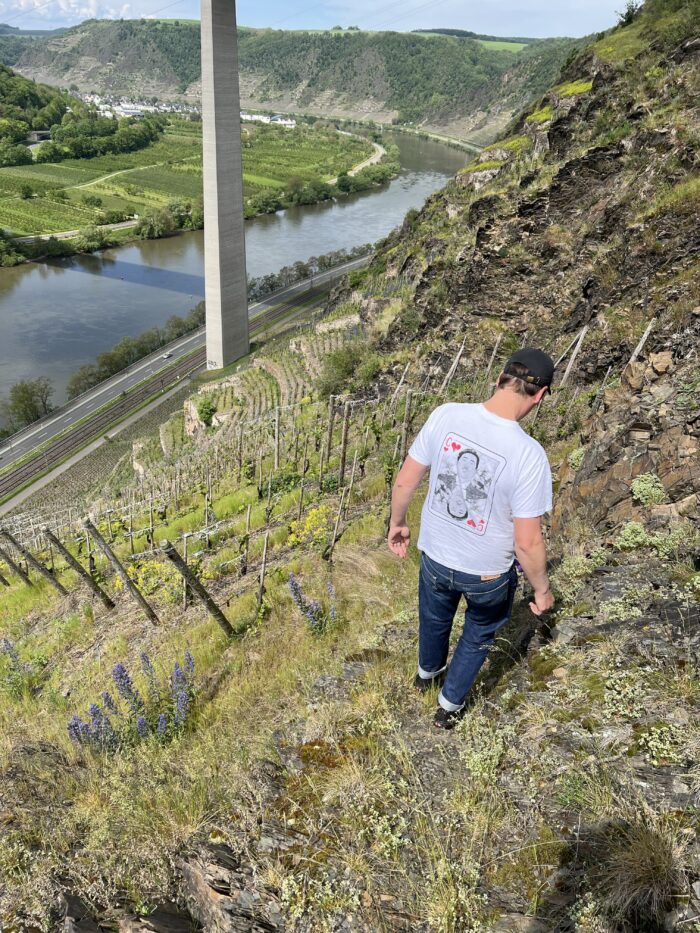
Julien Renard in the Terrassen-Mosel – no idea how this place gets its name.
As for the quality, it’s a bit too early to talk about the dry Rieslings of 2023; we’ll see. Young wines with residual sugar are a bit easier to read in the spring. For me, you can’t really start evaluating the dry wines until the fall. Yet I will say I’m optimistic from some preliminary tastings. The basic 2023 dry Riesling from Vollenweider, called “Felsenfest,” is a strong argument that the dry wines of 2023 can be very good. (It’s also a strong argument for how heterogeneous a vintage this is – here we are already contradicting an argument we made just a few paragraphs before, that the “basic” wines of 2023 are a bit fleshier – Vollenweider’s collection is just bonkers from top to bottom.) Julian Haart’s appellation-level “Moselle” is simply ravishing: electric pulses of mint, lime zest, green apples and ocean spray. This is one of those wines that denies nearly every stereotype of the vintage. Here is, for me, a “top-top” wine that will retail for $32? Absolutely nuts.
I told this to Julian who simply said to me: “Then you know how good the rest is.”
So there we are. It’s not an across-the-board blockbuster vintage, but there are some trophies to be had, some wines that will enter the cannon.
Maybe there is a karmic balance here, a little-articulated relationship between the labor and complexity of the vintage for the grower, and the labor and complexity of the vintage for the wine lover at home. The winemaker had to work extra hard this year to produce the top expression of the year. Now, you’re going to have to work a bit to find these wines.
The good news is we’re here to help.
Finally, and this is tangential to be sure, but part of the excitement right now also surrounds the release of the 2022 German Spätburgunders (Pinot Noirs). Many have said this is perhaps the greatest German vintage of Spätburgunder so far. Let’s see.
das Wetter | the weather
Analytically, vintage 2023 looks a little like 2022, as discussed briefly above: Ripeness levels were roughly the same. Acid levels were similar (some growers said a touch more acidity, some said a touch less). But this is maybe where the similarities end.
In a way, if vintage 2022 was defined by the dryness, maybe vintage 2023 was shaped by the rain, by the generous water throughout the latter part of the vintage?
But let’s start at the beginning. The winter was moderate, no great cold spells. This can be problematic as severe cold tends to kill future pests. I think we’re still learning how vines process a mild winter. It’s fun to anthropomorphize the vine, to suggest that without the winter slumber the vine comes into spring yawning and half-awake, wearing a dirty bathrobe, holding a cup of coffee a bit confused while rubbing its eyes and squinting. Yet plenty of vines hang out in much more moderate places. Either way, if the mildness was less than perfect there was at least plenty of rain – a godsend after the dry summer of 2022. Bud break occurred a bit early, which is of course normal at this point, and the good weather (if a bit dry and warm) lasted until the end of July, when things cooled down dramatically.
This coincided, naturally, with the vom Boden 10th anniversary party which we hosted at Ulli Stein’s home/hotel “Haus Waldfrieden” in the Mosel.
Not to make this all about me, but we had about 150 people coming to a space that could hold about 100 people. In other words, we were planning on using the outdoor space. This caused me a bit of stress, I won’t lie. I flew in a few weeks early to prep, and I remember standing there watching sheets of rain come down with my stomach in a knot, while Ulli stood there looking out the door with a huge smile. The rain was badly needed.
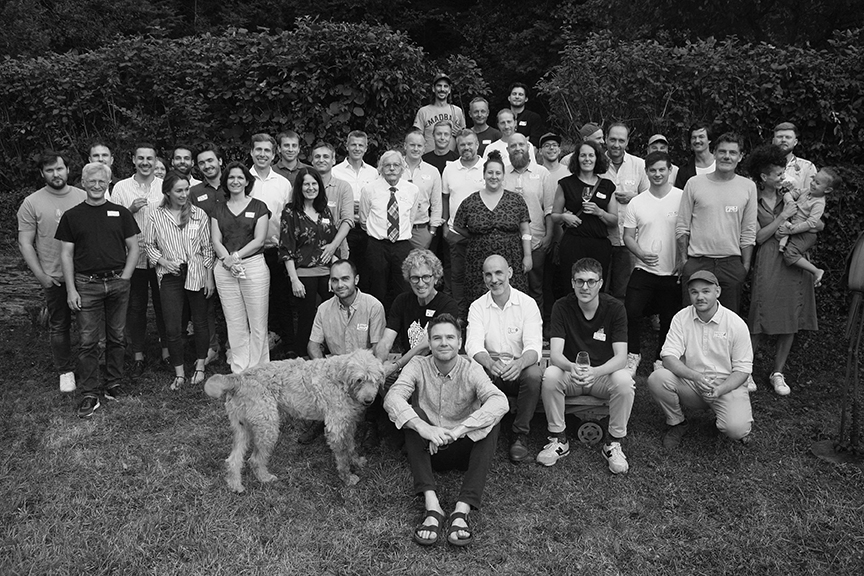
The weather looked great in black and white; July, 2023 in the Mosel at the vom Boden 10th anniversary party.
We had lovely weather for our party, thank you for asking, but it rained a lot before and after. And it was cool, which was nice. It felt refreshing. Most of the growers were pretty happy with the situation – the water refreshed the stocks that had been depleted.
August continued with rain, but it also had good bouts of sunshine. If you had controlled your yields, by early September you were coming into a good place, ripeness-wise. And, conveniently, the rains stopped in September so the growers did not have to worry (too much) about rain.
But the wet and warm August weather had left its mark and there was a lot of sorting to do. Nearly all the growers spoke of the absolutely maniacal sorting that was required. Alexandra Künstler (Weiser-Künstler) said they figured out a three-pronged sorting routine, involving 1) looking around the bunches of grapes, 2) looking into the center of the bunches and then, finally, 3) smelling the edited-bunches as a final measure to make sure nothing unpleasant came through.
Perhaps this is the essence of 2023? There is greatness there… truly – the key was isolating this greatness from everything else. Cause there was a lotta not-greatness out there too.
And, you had to do this very quickly in 2023; by October, the rains were back.
It feels to me like all the themes come back to our central concern: scale.
The small grower who could quickly adapt, change course, obsess over every grape – they are the ones who triumphed in 2023.
Moritz Hoffman, Daniel Vollenweider’s partner at the estate and now the head of this one-man show, shaped absolutely stunning, heartbreaking wines. When I tasted with him in March, I think he appreciated my fawning over the wines, my jaw on the table and the endless, heartfelt compliments.
But he replied: “We had a team of 16 people for about four hectares.” And then he sighed.
Maybe this is one of the great truisms for 2023: If the wines are absolute highlights of the vintage – and they are – they will not be particularly profitable. For greatness in 2023, you had to pay.
And to find greatness in 2023, you’ll have to work a bit yourself.
But as we said, that’s the fun… and we are here and excited to help: orders@vomboden.com
Der Epilog | Epilogue
Recently, a group of friends and I went back and did a pretty comprehensive tasting of the 2014ers – a year in some ways similar to 2023, at least in so far as it presented some challenges and was, well, overlooked. I have a son born in 2014, so I have a bit in the cellar and at ten years down the road, it seemed a good moment to do a little #Rieslingstudy. You know, for the boy. To check in on his cellar.
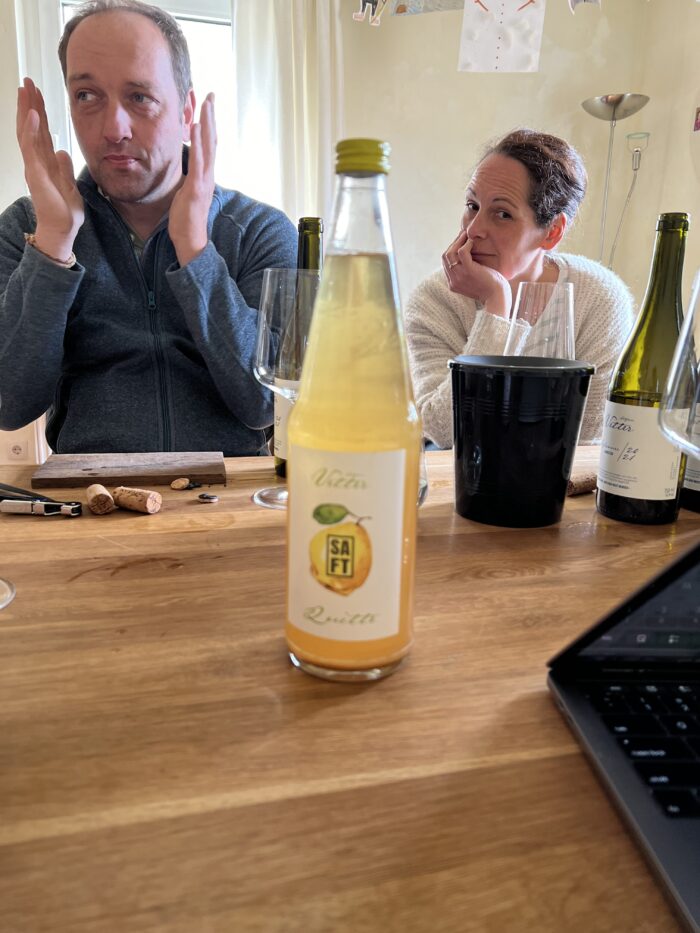
Stefan and Katja Vetter know – don’t underestimate a vintage. The difference is what we seek!
I think we were all honestly shocked by how good the wines were – across the board.
I texted with Keller the next day, relating to him that the dry flight of wines had three obvious superstars: his Abtserde GG, Tim Fröhlich’s Felseneck GG and Florian Lauer’s Schonfels GG.
He responded quickly: “Of course – in a vintage like 2014 the great sites rise to the occasion.”
The text caught me off guard a little.
Here we had focused this entire silly dinner on the vintage, on 2014, hoping to find some great truth about the vintage.
We made the mistake of forgetting about the site, the terroir, and in turn, the grower.
I have the feeling that in ten years’ time someone will have a similar moment, tasting through the top 2023ers, with its heterogeneous offerings. At its best, the top 2023ers are absolutely spellbinding, intense more than full, sublime and balanced.
In these cases, one can forget about the vintage and marvel at the profundity of the site. It doesn’t get much better than that.